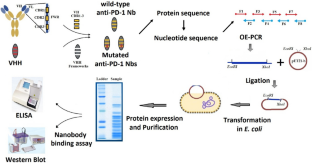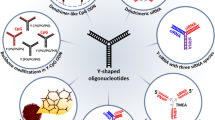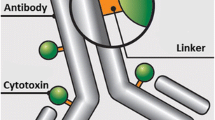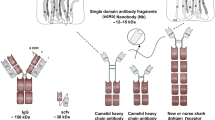Abstract
Programmed cell death protein-1 (PD-1) is a membrane protein expressed on the surface of activated T-cells, B-cells, natural killer cells, dendritic cells, macrophages, and monocytes. Inhibition of the PD-1/PD-L1 interaction by monoclonal antibodies (mAbs) has many therapeutic benefits and has led to a major advance in the treatment of various types of tumors. Due to the large size and immunogenicity of the antibodies (Abs), using small molecules such as nanobodies (nanobodies or VHH) is more appropriate for this purpose. In this research, the complementarity determining regions (CDR) grafting method was used to produce anti-PD-1 nanobody. For producing the grafted anti-PD-1 nanobody, CDRs from the tislelizumab mAb were grafted into the frameworks of a nanobody whose sequence is similar to the tislelizumab mAb. Also, the site-directed mutagenesis method was used to produce two mutated anti-PD-1 nanobodies which increased the affinity of grafted anti-PD-1 nanobodies. Two amino acid substitutions (Tyr97Arg and Tyr102Arg) in the VHH-CDR3 were used to improve grafted nanobody affinity and the binding capacity of the mutated nanobodies. The binding of the anti-PD-1 nanobodies and PD-1 antigen (Ag) was confirmed by Dot blot, western blot, and indirect ELISA analysis. According to the results of these in silico and in vitro studies, the binding between grafted and mutated nanobodies with PD-1 was confirmed. Also, our findings show that site-directed mutagenesis can increase the affinity of nanobodies.






Similar content being viewed by others
Data Availability
All experimental data generated or analyzed during this study are included in the article.
Abbreviations
- mAb:
-
Monoclonal antibodies
- PD-1:
-
Programmed cell death protein-1
- Ab:
-
Antibody
- CDR:
-
Complementarity determining regions
- Ag:
-
Antigen
- ICI:
-
Immune checkpoint inhibitor
- VH:
-
Heavy chain
- PVDF:
-
Polyvinylidene fluoride
References
Pucci, C., Martinelli, C., & Ciofani, G. (2019). Innovative approaches for cancer treatment: Current perspectives and new challenges. Ecancermedicalscience, 13, 961–987.
Tan, S., Li, D., & Zhu, X. (2020). Cancer immunotherapy: Pros, cons and beyond. Biomedicine & Pharmacotherapy, 124, 109821–109832.
Shiravand, Y., Khodadadi, F., Kashani, S. M. A., Hosseini-Fard, S. R., Hosseini, S., Sadeghirad, H., Ladwa, R., O’Byrne, K., & Kulasinghe, A. (2022). Immune checkpoint inhibitors in cancer therapy. Current Oncology, 29, 3044–3060.
Topalian, S. L., Drake, C. G., & Pardoll, D. M. (2015). Immune checkpoint blockade: A common denominator approach to cancer therapy. Cancer Cell, 27, 450–461.
Han, Y., Liu, D., & Li, L. (2020). PD-1/PD-L1 pathway: Current researches in cancer. American Journal of Cancer Research, 10, 727–742.
McDermott, D. F., & Atkins, M. B. (2013). PD-1 as a potential target in cancer therapy. Cancer Medicine, 2, 662–673.
Ahmadzadeh, M., Johnson, L. A., Heemskerk, B., Wunderlich, J. R., Dudley, M. E., White, D. E., & Rosenberg, S. A. (2009). Tumor antigen-specific CD8 T cells infiltrating the tumor express high levels of PD-1 and are functionally impaired. Blood American Journal of Hematology, 114, 1537–1544.
Sharpe, A. H., Wherry, E. J., Ahmed, R., & Freeman, G. J. (2007). The function of programmed cell death 1 and its ligands in regulating autoimmunity and infection. Nature Immunology, 8, 239–245.
Ohaegbulam, K. C., Assal, A., Lazar-Molnar, E., Yao, Y., & Zang, X. (2015). Human cancer immunotherapy with antibodies to the PD-1 and PD-L1 pathway. Trends in Molecular Medicine, 21, 24–33.
Lee, A., & Keam, S. J. (2020). Tislelizumab: First approval. Drugs, 80, 617–624.
Tan, S., Zhang, C. W., & Gao, G. F. (2016). Seeing is believing: Anti-PD-1/PD-L1 monoclonal antibodies in action for checkpoint blockade tumor immunotherapy. Signal Transduction and Targeted Therapy, 1, 1–4.
Feng, Y., Hong, Y., Sun, H., Zhang, B., Wu, H., Li, K., Liu, X., & Liu, Y. (2019). The molecular binding mechanism of tislelizumab, an investigational anti-PD-1 antibody, is differentiated from pembrolizumab and nivolumab. In: Proceedings of the 110th annual meeting of the American association for cancer research. Atlanta, GA: AACR.
Shen, L., Guo, J., Zhang, Q., Pan, H., Yuan, Y., Bai, Y., Liu, T., Zhou, Q., Zhao, J., & Shu, Y. (2020). Tislelizumab in Chinese patients with advanced solid tumors: An open-label, non-comparative, phase 1/2 study. JITC, 8, e000437.
Bannas, P., Hambach, J., & Koch-Nolte, F. (2017). Nanobodies and nanobody-based human heavy chain antibodies as antitumor therapeutics. Frontiers in Immunology, 8, 1603–1616.
Cruz, E., & Kayser, V. (2019). Monoclonal antibody therapy of solid tumors: clinical limitations and novel strategies to enhance treatment efficacy. Biologics: Targets and Therapy, 13, 33–51.
Gravbrot, N., Gilbert-Gard, K., Mehta, P., Ghotmi, Y., Banerjee, M., Mazis, C., & Sundararajan, S. (2019). Therapeutic monoclonal antibodies targeting immune checkpoints for the treatment of solid tumors. Antibodies, 8, 51–116.
De Meyer, T., Muyldermans, S., & Depicker, A. (2014). Nanobody-based products as research and diagnostic tools. Trends in Biotechnology, 32, 263–270.
Hu, Y., Liu, C., & Muyldermans, S. (2017). Nanobody-based delivery systems for diagnosis and targeted tumor therapy. Frontiers in Immunology, 8, 1442–1459.
Van Audenhove, I., & Gettemans, J. (2016). Nanobodies as versatile tools to understand, diagnose, visualize and treat cancer. eBioMedicine, 8, 40–48.
Muyldermans, S. (2021). A guide to: Generation and design of nanobodies. FEBS Journal, 288, 2084–2102.
Wagner, H. J., Wehrle, S., Weiss, E., Cavallari, M., & Weber, W. (2018). A two-step approach for the design and generation of nanobodies. International Journal of Molecular Sciences, 19, 3444–3461.
Kim, H.-Y., Stojadinovic, A., & Izadjoo, M. J. (2014). Affinity maturation of monoclonal antibodies by multi-site-directed mutagenesis. Monoclonal Antibodies: Methods and Protocols, 1131, 407–420.
Wang, X., Chen, Q., Sun, Z., Wang, Y., Su, B., Zhang, C., Cao, H., & Liu, X. (2020). Nanobody affinity improvement: Directed evolution of the anti-ochratoxin A single domain antibody. International Journal of Biological Macromolecules, 151, 312–321.
Wark, K. L., & Hudson, P. J. (2006). Latest technologies for the enhancement of antibody affinity. Advanced Drug Delivery Reviews, 58, 657–670.
Ye, W., Liu, X., He, R., Gou, L., Lu, M., Yang, G., Wen, J., Wang, X., Liu, F., & Ma, S. (2022). Improving antibody affinity through in vitro mutagenesis in complementarity determining regions. Journal of Biomedical Research, 36, 155–166.
Li, G., Dong, B.-X., Liu, Y.-H., Li, C.-J., & Zhang, L.-P. (2013). Gene synthesis method based on overlap extension PCR and DNAWorks program. Methods in Molecular Biology, 1073, 9–17.
Jiang, Y., Chen, M., Nie, H., & Yuan, Y. (2019). PD-1 and PD-L1 in cancer immunotherapy: Clinical implications and future considerations. Human Vaccines & Immunotherapeutics, 15, 1111–1122.
Liu, S.-Y., & Wu, Y.-L. (2020). Tislelizumab: An investigational anti-PD-1 antibody for the treatment of advanced non-small cell lung cancer (NSCLC). Expert Opinion on Investigational Drugs, 29, 1355–1364.
Topalian, S. L., Drake, C. G., & Pardoll, D. M. (2012). Targeting the PD-1/B7-H1 (PD-L1) pathway to activate anti-tumor immunity. Current Opinion in Immunology, 24, 207–212.
Zheng, X., Gu, H., Cao, X., Pan, B., Xiang, H., Ju, M., Xu, S., & Zheng, M. (2023). Tislelizumab for cervical cancer: A retrospective study and analysis of correlative blood biomarkers. Frontiers in Immunology, 14, 1113369–1113387.
Unciti-Broceta, J. D., Del Castillo, T., Soriano, M., Magez, S., & Garcia-Salcedo, J. A. (2013). Novel therapy based on camelid nanobodies. Therapeutic Delivery, 4, 1321–1336.
Yang, E. Y., & Shah, K. (2020). Nanobodies: Next generation of cancer diagnostics and therapeutics. Frontiers in Oncology, 10, 1182–1199.
Arezumand, R., Alibakhshi, A., Ranjbari, J., Ramazani, A., & Muyldermans, S. (2017). Nanobodies as novel agents for targeting angiogenesis in solid cancers. Frontiers in Immunology, 8, 1746–1759.
Deffar, K., Shi, H., Li, L., Wang, X., & Zhu, X. (2009). Nanobodies-the new concept in antibody engineering. AJB, 8, 2645–2652.
Shi, W., Yang, X., Xie, S., Zhong, D., Lin, X., Ding, Z., Duan, S., Mo, F., Liu, A., & Yin, S. (2021). A new PD-1-specific nanobody enhances the antitumor activity of T-cells in synergy with dendritic cell vaccine. Cancer Letters, 522, 184–197.
Zhang, Y., Yang, S., Jiang, D., Li, Y., Ma, S., Wang, L., Li, G., Wang, H., Zhang, A., & Xu, G. (2023). Screening and identification of an anti-PD-1 nanobody with antitumor activity. Bioscience Reports, 43, BSR20221546.
Carter, P. (1986). Site-directed mutagenesis. The Biochemical Journal, 237, 1–7.
Lim, C. C., Choong, Y. S., & Lim, T. S. (2019). Cognizance of molecular methods for the generation of mutagenic phage display antibody libraries for affinity maturation. International Journal of Molecular Sciences, 20, 1861–1893.
Acknowledgements
The authors thank the Yazd University Research Council for the support of this research.
Funding
This research did not receive any specific grant from funding agencies in the public, commercial, or not-for-profit sectors.
Author information
Authors and Affiliations
Contributions
Conceptualization, M.M.H. and M.K.; methodology, M.M. and S.M.; formal analysis and investigation, M.M.H., M.K., M.M. and S.M; writing—original draft preparation, M.M.; writing—review and editing, J M.M.H. and M.K.; supervision, M.M.H. All authors have read and agreed to the published version of the manuscript.
Corresponding author
Ethics declarations
Conflict of interest
The authors declare no conflict of interest.
Informed consent
Not applicable.
Additional information
Publisher's Note
Springer Nature remains neutral with regard to jurisdictional claims in published maps and institutional affiliations.
Rights and permissions
Springer Nature or its licensor (e.g. a society or other partner) holds exclusive rights to this article under a publishing agreement with the author(s) or other rightsholder(s); author self-archiving of the accepted manuscript version of this article is solely governed by the terms of such publishing agreement and applicable law.
About this article
Cite this article
Mirzaei, M., Mirhoseini, S., Heidari, M.M. et al. Design and Production of a Novel Anti-PD-1 Nanobody by CDR Grafting and Site-Directed Mutagenesis Approach. Mol Biotechnol (2024). https://doi.org/10.1007/s12033-024-01162-1
Received:
Accepted:
Published:
DOI: https://doi.org/10.1007/s12033-024-01162-1




